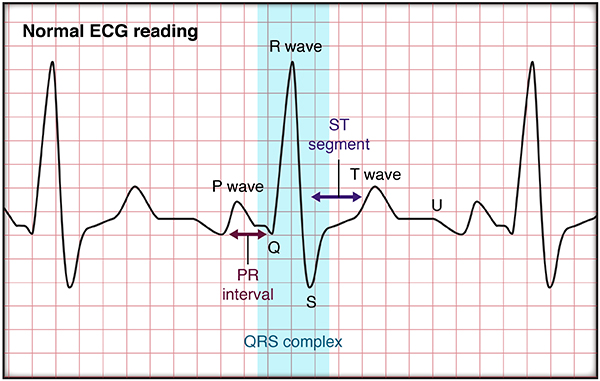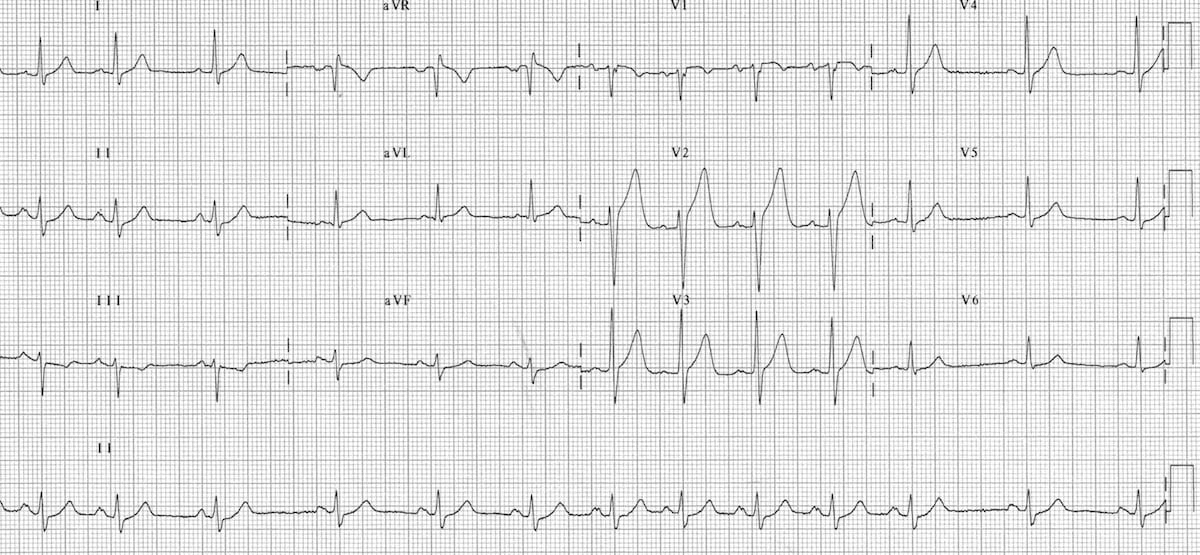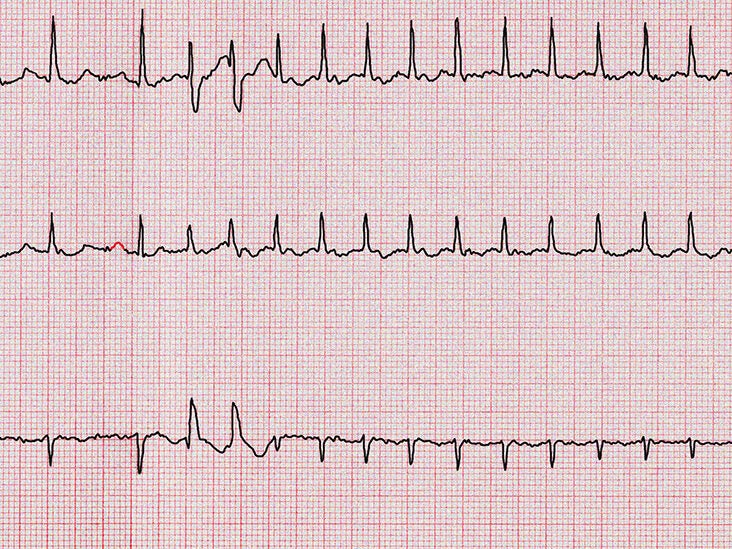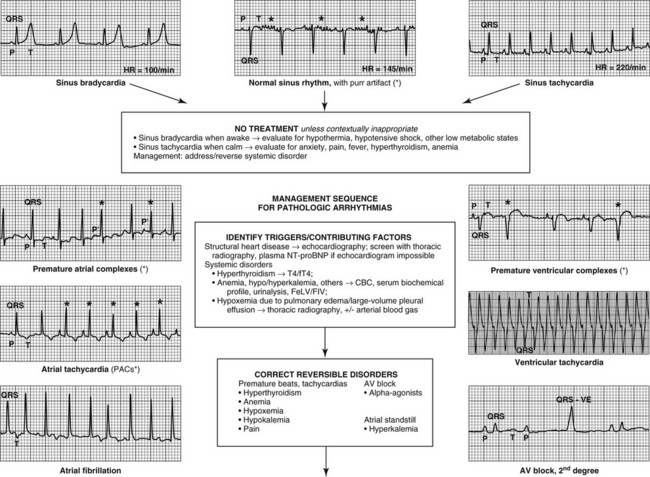[最も人気のある!] abnormal sinus rhythm ecg 176475-Abnormal sinus rhythm ecg
Sinus tachycardia = sinus rhythm with heart rate >100 BPM in adults (or above normal ageadjusted range in children) Sinus arrhythmia = sinus rhythm with beattobeat variation in the PP interval (ie, time between successive P waves);A sinus rhythm is any cardiac rhythm in which depolarisation of the cardiac muscle begins at the sinus node It is characterised by the presence of correctly oriented P waves on the electrocardiogram (ECG) Sinus rhythm is necessary, but not sufficient, for normal electrical activity within the heart The term normal sinus rhythm (NSR) is sometimes used to denote a specific type of sinusJun 01, · An arrhythmia is an uneven heart rhythm Learn more about the symptoms, causes, types, risk factors, diagnosis, treatment, complications, and prevention of arrhythmia

Ecg Abnormalities Can Predict Covid 19 Mortality
Abnormal sinus rhythm ecg
Abnormal sinus rhythm ecg-Sinus Rhythm means you heart is beating at a steady consistent rate A first degree AV block means that the electrical signal that starts in the Atria (upper chambers) of the heart and is relayed to the Ventricles (lower chambers) of the heart, is taking too long to get there It's sometimes referred to on the EKG as a prolonged PR timeSinus Rhythm EKG (ECG) Tracing EKG tracings are printed on grid paper or displayed on a patient monitor These tracings, the EKG waveform, have key features which indicate sinus rhythm or abnormalities (arrhythmias) There are six wave components which are commonly analyzed in determining if the EKG is a sinus rhythm



1
Sinus tachycardia causes, ECG, normal variants & pathological variants Sinus tachycardia is the most common tachyarrhythmia (tachycardia) Sinus tachycardia is the result of an increased rate of depolarization (ie increased automaticity) in the sinoatrial nodeThis simply means that the sinoatrial node discharges electrical impulses at a higher frequency than normalMar 22, · Sinus rhythm (aka normal sinus rhythm) refers to the normal heart beat originating from the sinoatrial node Sinus bradycardia occurs when the heart rate is less than 60 beats per minute and sinus tachycardia when the heart rates is greater than 100 beats per minute in the setting of a sinus P wave on the ECGThus the term, nonspecific STT wave abnormalities, is frequently used when the clinical data are not available to correlate with the ECG findings This does not mean that the ECG changes are unimportant!
Rate 300 ÷ number of squares in RR interval;Apr 09, 19 · Sometimes, an abnormal EKG reading is actually just a normal variation in a person's heart rhythm In other cases, it may be due to an underlying conditionMy ecg results impression sinus rhythm impression right atria abnormality Heart rate 95 What does this m How It Works 1 Uncertain about your diagnosis or if their treatment options are complicated, risky, or unpleasant?
Normal Sinus Rhythm Sinus rhythm is the normal regular rhythm of the heart set by the natural pacemaker of the heart called the sinoatrial node It is located in the wall of the right atrium Normal cardiac impulses start there and are transmitted to the atria and down to the ventriclesOct 06, 16 · In this lesson, we'll look more closely at an example of a normal sinus rhythm on an ECG (aka EKG) for an adult patient and see what findings and measurements are considered normal, and what to be on the lookout for that would be considered abnormal And at the end of the lesson, we'll provide a Word about acute coronary syndromeBasically you have a normal ECG reading according to the machine Sinus rhythm (as explained in the first section of this book chapter) is normal, meaning that the heart is depolarized by a wave starting in the sinus nodeThat is the first part of the message It is worth noting, that if your heart rate had been 1 beat per minute less, it would have probably said "sinus bradycardia" as a




Sinus Rhythm High Res Stock Images Shutterstock




Overview Of Abnormal Heart Rhythms Heart And Blood Vessel Disorders Merck Manuals Consumer Version
Nov 12, 17 · Sinus arrhythmia means there is an irregularity in the heart rhythm, originating at the sinus node In general, sinus arrhythmias can be SinusJan 02, 18 · Sinus tachycardia occurs when your sinus node sends too many electrical impulses in a certain amount of time, leading to a faster heartJul 30, 17 · An arrhythmia is an abnormal rate and/or rhythm of the heartbeat There are various types but all are due to some problem with the electrical conducting system of the heart Some arrhythmias are more serious than others Some come and go (are intermittent);




Ekg Normal Sinus Rythms Sinus Bradycardia More Leveluprn




Normal Ecg
Aug 28, · ECG abnormalities in P – wave P – wave represents the atrial depolarization P wave abnormalities indicate that there is something problem in your upper chamber (atrium) of the heart Multiple Pwave forms If there are multiple P waveforms in ECG pattern followed by a QRS complex, is called Atrial TachycardiaThis results in a regularly irregular rhythmMy results for the ekg said Vent rate 79 bpm PR interval 170 ms QRS duration 96 ms QT/QTc 384/440 ms PRT axes 28 46 14 Normal sinus rhythm Cannot rule out Anterior infarct, age undetermined Abnormal ECG




Normal Sinus Rhythm An Overview Sciencedirect Topics




Ecg Abnormalities Can Predict Covid 19 Mortality
Jun 15, 11 · 40,500 satisfied customers My EKG said sinus rhythm rapid premature ventricular my EKG said sinus rhythm rapid premature ventricular complexes right atrial overload P >025 mV in II P =118 ms septal infarct QS in V1 V2 REvidence of impaired atrioventricular conduction such as 2nd degree heart block ;Rate >350 (atrial)/varies (ventricular), Rhythm Irregularly irregular, PWaves nondiscernable, PRI not measurable, QRS




Common Examples Of Abnormal Ecgs 11 A Normal Sinus Rhythm B Download Scientific Diagram



3
Answer E Sinus arrhythmia The child has sinus arrhythmia, which is particularly impressive in this ECG Sinus arrhythmia is an exaggerated but normal variation of the sinus rhythm that occurs with respiration On examination, this may be prominent enough to manifest as an irregular pulseDec 05, · Rhythm Abnormalities Rhythms can originate in 3 places in the heart – the SA node, the region around the AV node (known as nodal, or junctional rhythm), or the ventricular muscle Sinus Rhythm This means that the rhythm of the heart is being controlled by the SA node – ie this is the 'normal' rhythm of the heartOthers are permanent unless treated Tachycardia means a faster heart rate than usual




Figure Ecg Reading The Waves Msd Manual Consumer Version




Sinus Arrhythmia What Is It
Mar , 21 · PVC marked by the arrow on an EKG in sinus rhythm The compensatory pause is marked in blue The ectopic impulses on the electrocardiogram are premature in relation to the expected impulse of the basic rhythm The QRS complex is abnormal in duration and morphology It is accompanied by secondary ST segment and T wave changesThe ventricular rate is slow and irregularA variability of over 400ms




Ecg Demonstrates Sinus Arrhythmia Note The Irregular Heart Rate That Download Scientific Diagram




Detecting Heart Arrhythmias With Deep Learning In Keras With Dense Cnn And Lstm By Andrew Long Towards Data Science
Sinus Arrhythmia ECG (Example 3) Sinus Bradycardia ECG (Example 1) Electrolyte and Metabolic Abnormalities Hyperkalemia ECG (Example 1) Hyperkalemia ECG (Example 2)Feb 07, 21 · How to determine if the ECG has a Normal Sinus Rhythm To determine whether the ECG has a Normal Sinus Rhythm should consider the following features It should have a positive P Wave at DI, DII, and aVF In addition to Precordial Leads V2 to V6 And negative on aVR There should be a QRS complex followed by each P wave The rhythm must be regularNormal sinus rhythm is the default cardiac rhythm that represents the normal electrical activity through the heart Electrical impulses start at the sinoatr




Abnormal Sinus Rhythms A Bradycardia What Is The Chegg Com




Sinus Arrhythmia Definition Signs And Diagnosis
Regularly irregular Sinus arrhythmia;Dec 25, · Arrhythmia is an abnormal rhythm of the heart The only normal rhythm of the heart is a normal sinus rhythm In this rhythm, an impulse is generated in the sinoatrial (SA) node, which is conducted through and slowed down while passing through the atrioventricular node (AV) It is then conducted through the bundle of His, to the left and right bundle branches, andSep 01, 07 · The rhythm in this tracing (shown in Figure 1 with the ventricular beats/ QRS complexes numbered on the lead II rhythm strip at the bottom) appears to be irregularly irregular If it were regularly irregular, several ECG diagnoses would move up in the differential diagnosis namely, normal sinus rhythm (NSR) with a regular bigeminal, trigeminal



The 12 Rhythms Of Christmas Sinus Tachycardia Ems 12 Lead




Figure 3 From Abnormal Ecgs Secondary To Electrolyte Abnormalities Semantic Scholar
Check out the series on cardiovascular disease, https//wwwyoutubecom/watch?v=dvVPomFoAug 01, 18 · Normal sinus P waves (upright in leads I and II) with a constant morphology — albeit with an appearance suggestive of left atrial enlargement PR interval is constant (no evidence of AV block) The PP interval varies widely from 104 seconds (heart rate ~57 bpm) down to 060 seconds (heart rate ~100 bpm);Normal sinus rhythm PR INTERVAL 132 ms Vent rate 76bpm Qrs duration 84 ms Q My Ecg rsult reads P/PR 122/152ms QRS 78 ms QT/QTc 356/454ms P/QRS/T Axis Sinus rhythm rate = 72 QRSD = 131 QT = 440 QTc = 4 Axis P 65 QRS 70 T 7 o




Diagnosis Of Heart Disease Circulatory System Merck Veterinary Manual




Sinus Rhythm Normal Function Of The Heart Cardiology Teaching Package Practice Learning Division Of Nursing The University Of Nottingham
• Sinus tachycardia is a sinus rhythm that's faster than the upper normal sinus rate of 100 beats/minute Sinus tachycardia can produce heart rates of 100 to 150 beats/minute At faster rates, the heart's myocardial oxygen demand increases, and a patient with preexisting heart disease may experience chest discomfort or other signs and symptomsAST segment and T wave are ECG terminologies and these are arbitrary names given to certain segments of the tracings of the ECGSTT wave changes can occur in a numberEKG waveforms are displayed on monitors or paper These EKG tracings have important features which can be analyzed to reveal a normal or an abnormal rhythm (a dysrhythmia) EKG can include various waveform components which are can be interpreted to understand if the EKG is a sinus rhythm or abnormal P Wave




Irregular Rhythm In A Young Person Ecg Guru Instructor Resources




Ekg Interpretation
Nov 25, 19 · Ecg shows a nonspecdific st abnormality, normal sinus rhythm, abnormal ecg Vent , pr 134, qrs 80 qt/qtc 378/441, prt 58/50/53 Whats this mean?OR Count number of QRS complexes in a given number of seconds (eg 5 secs = 25 large squares), then calculate rate per min (multiply by 12 for a 5 second period) Should be bpm for atria & ventricles (PP and RROct 01, 08 · Normal Sinus Rhythm Normal depolarization and repolarization of the heart produces a characteristic ECG rhythm Interpretation of this ECG includes determination of rate, presence of normal wave amplitudes, and correct intervals between the portions of the ECG Normally, the first step in heart depolarization is the depolarization of the SA node




Ecg Interpretation Of Arrhythmias Tusom Pharmwiki




Wide Complex Tachycardia In Ischemic Heart Disease Patient What Is The Rhythm
Jan 05, 21 · Common reading "abnormal" because there are nonspecific changes which are not specific enough to meet a true diagnosis, but not normal enough to say normal, so somewhat of a soft call or indecisive read, but very common and does not necessarily mean anything The bottom line, the ECG findings need to be placed in the clinical context in which it was taken, and compared to previous and subsequent ECGsSinus bradycardia ECG, causes & management Definition of sinus bradycardia Sinus bradycardia fulfills the criteria for sinus rhythm but the heart rate isThe table below lists many types of abnormal EKG which are described in this guide Accelerated Idioventricular Rhythm Accelerated Junctional Rhythm Asystole Atrial Fibrillation Atrial Flutter Bundle Branch Block First Degree Heart Block Idioventricular Rhythm




Arrhythmias Anesthesia Key




Electrocardiography Diagnosis And Management Of Common Arrhythmias Wsava13 Vin
Dec 27, 17 · Q I am a 41 years old man and I underwent a routine ECG and the report showed sinus rhythm, left axis, nonspecific STT abnormality (elevated)Otherwise it was a normal ECG What does it mean?Sinus arrhythmia is a normal physiological phenomenon and it is considered a variation of normal sinus rhythm It is defined as an irregularity in the rate of normal sinus rhythm Its main characteristic on the EKG is a variation in the PP intervals greater than 012 s with a normal P wave morphology 1 2Apr 07, · Abnormal ECG results are associated with conditions such as heart failure, atrial fibrillation, sick sinus syndrome and multifocal atrial tachycardia An abnormal reading may also be caused by heart attack, congenital heart defects, inadequate blood supply to the coronary arteries, damage to the heart muscle or inflammation of the heart




Pin On Med School




The Normal Ecg And Different Types Of Ventricular Arrhythmias A Download Scientific Diagram
The rhythm is similar to normal sinus rhythm, except that the RR interval is less than 06 seconds The a wave may tend to merge with the v wave in the CVP trace, and the P wave may be obscured by the T wave in the ECG (not apparent in this trace)This is called a normal sinus rhythm When it's not, you could have an irregular heartbeat called AFib You probably don't think much about your heartbeat because it happens so easilyThe ECG shows a number of findings consistent with TCA overdose sinus tachycardia, prolonged QRS interval, rightward axis, tall R wave in lead aVR, and abnormal repolarization TCAs block fast




Ekg S Internal Medicine University Of Nebraska Medical Center




Arrhythmias Cedars Sinai
Aug 01, 18 · Sinus bradycardia = sinus rhythm with resting heart rate < 60 bpm in adults, or below the normal range for age in children Sinus arrhythmia = sinus rhythm with a beattobeat variation in the PP interval (the time between successive P waves), producing anDec 24, · I had abnormal ekg where it said normal sinus rhythm, cannot rule out anterior infraction, age undetermined, nonspecific t wave abnormalities no longer evident in inferior leadsThen my troponin 1 levels came back normal the doctor in the hospital did not mention anything to me I have postpartum preeclampsia with high blood pressure they prescribed meSinus bradycardiaoccurs when the heart rate is less than 60 beats per minute and sinus tachycardiawhen the heart rates is greater than 100 beats per minute in the setting of a sinus




Top 5 Arrhythmias In Dogs Cats Clinician S Brief




Sinus Arrhythmia
Share Case details Diagnosis if any, Your medical reports, Specific questions you would like to have answeredIt is the responsibility of the clinician providing care for the patient to ascertain the importance of the ECG findingsECG findings (may include any of the following) A slow and irregular atrial rate (impaired sinoatrial activity), severe sinus bradycardia, or long pauses of asystole with no escape beats;




The Ekg Of Our Patient Showed Sinus Rhythm Of 62 Min An Abnormal Left Download Scientific Diagram




Sinus Rhythm Wikipedia




Sinus Tachycardia Wikipedia




Ecg Interpretation Ecg Blog 152 Qtc Ecg Lists Sinus Rhythm




Rhythm Recognition Acls Medical Training



1




An Apple Watch Told A 46 Year Old Man He Had An Irregular Heartbeat It Was Right Abc News




Unique Ecg During Sinus Rhythm In A Patient With A Postmyocardial Infarction Sustained Ventricular Tachycardia Circulation




Top 5 Arrhythmias In Dogs Cats Clinician S Brief




Module 1 Introduction To Ecg Normal Ecg Importance




Sinus Arrhythmia Litfl Medical Blog Ecg Library Basics




Detection Of Arrhythmia Acs Should Not Solely Rely On Ecg Interpretation Programs The Cardiology Advisor



Section 5 Sinus Rhythms




10 Best Endocrine Hormones Ideas In 21 Cardiac Nursing Ekg Interpretation Nursing School Notes




Ecglibrary Com Normal Adult 12 Lead Ecg




Ekg Interpretation




Sinus Arrhythmia Respiratory Sinus Arrhythmia Ecg Echo




Cardiac Rhythm Disorders In Children Prezentaciya Onlajn



The 12 Rhythms Of Christmas Sinus Tachycardia Ems 12 Lead




56 Cardiac Arrhythmias Ideas Cardiac Arrhythmia Cardiac Cardiac Nursing




Ecg Demonstrates Sinus Arrhythmia Note The Irregular Heart Rate That Download Scientific Diagram




Top 5 Arrhythmias In Dogs Cats Clinician S Brief




Fusion Of Ecg And Abp Signals Based On Wavelet Transform For Cardiac Arrhythmias Classification Sciencedirect




Non Invasive Evaluation Of Arrhythmias




Arrhythmias Overview Of The Condition The Pharmaceutical Journal




Sinus Arrhythmia Ecg High Res Stock Images Shutterstock




Sinus Arrhythmia Definition Signs And Diagnosis



Sinus Rhythm Wikipedia




Feline Cardiac Arrhythmias Veterian Key



Ecg A Pictorial Primer




Sinus Rhythm Physiology Ecg Criteria Clinical Implications Ecg Echo




Electrocardiography Bioninja



The 12 Rhythms Of Christmas Sinus Tachycardia Ems 12 Lead




Common Examples Of Abnormal Ecgs 11 A Normal Sinus Rhythm B Download Scientific Diagram



1




Automatic Diagnosis Of The 12 Lead Ecg Using A Deep Neural Network Nature Communications



Common Arrhythmias In Dogs And Cats
/GettyImages-139820244-56a471823df78cf772826b4f.jpg)



What Is Normal Sinus Rhythm




Normal Sinus Rhythm Training Cardiac Arrhythmias Video Propals




Abnormal Heart Rhythm Hd Stock Images Shutterstock




Using Your Knowledge Resources Text Book And Or Chegg Com



Arrhythmias Learnpicu




Cv Physiology Abnormal Rhythms Definitions




Ecg Cardiac Arrhythmias Youtube




Sinus Rhythm Physiology Ecg Criteria Clinical Implications Ecg Echo




New Page 1




Ecg Arrhythmias



3




Sinus Arrhythmia Litfl Medical Blog Ecg Library Basics




Irregular Narrow Complex Tachycardia Circulation




Normal Sinus Rhythm Ekg Ecg Interpretation Youtube




Ekg Interpretation Cheat Sheet Heart Arrhythmias Guide Update




Pin On Ecg Module 1




Heart Rhythm Problems Arrhythmias




Rhythm Recognition Acls Medical Training




Sinus Arrhythmia Ecg High Res Stock Images Shutterstock



Stock Image Abnormal Electrocardiogram Showing A Sinus Rhythm At A Rateof 57 A First Degree Av Block And A Left Bundle Branch Block Abnormal Electrocardiogram Of A 91 Year Old Woman Showinga



Ecg A Pictorial Primer




Sinus Tachycardia Wikipedia




Examples Answers Legend Ekg




The Ekg Of Our Patient Showed Sinus Rhythm Of 62 Min An Abnormal Left Download Scientific Diagram



Rhythm Strip Flash Card Practice



Case 11 Results




Normal Sinus Rhythm Litfl Medical Blog Ecg Library Basics




Sensors Free Full Text A Survey Of Heart Anomaly Detection Using Ambulatory Electrocardiogram Ecg Html




Normal And Abnormal Ecg Youtube




Ecg Arrhythmias In Non Implanted Vs Telemetry Implanted Dogs Need For Screening Before And Sufficient Recovery Time After Implantation Sciencedirect




Heart Rhythms What S Normal Versus Cause For Concern Johns Hopkins Medicine




Electrocardiography Radiology Key




Sinus Tach Or Svt 4 Clues To Tell The Difference




Ecg Demonstrates Sinus Arrhythmia Note The Irregular Heart Rate That Download Scientific Diagram




Ecg Arrhythmias




6 Atrial Flutter Treatment Symptoms Ecg Serious Vs Afib




Rhythm Recognition Acls Medical Training


コメント
コメントを投稿